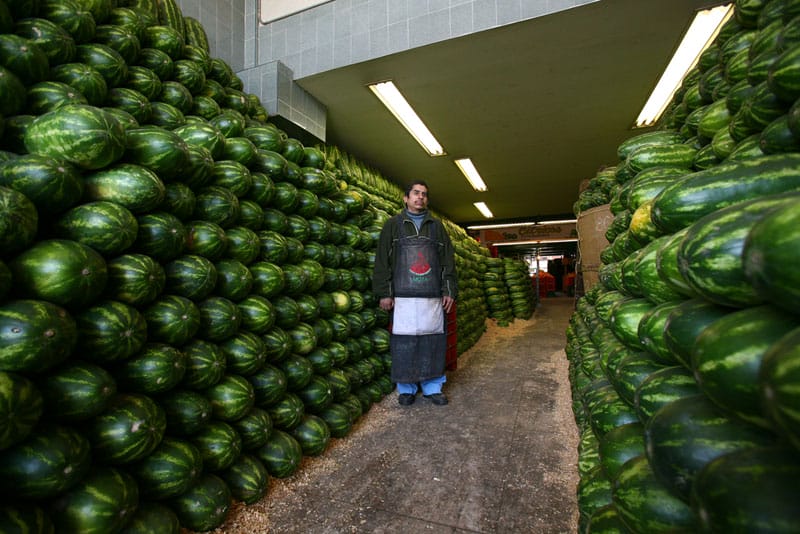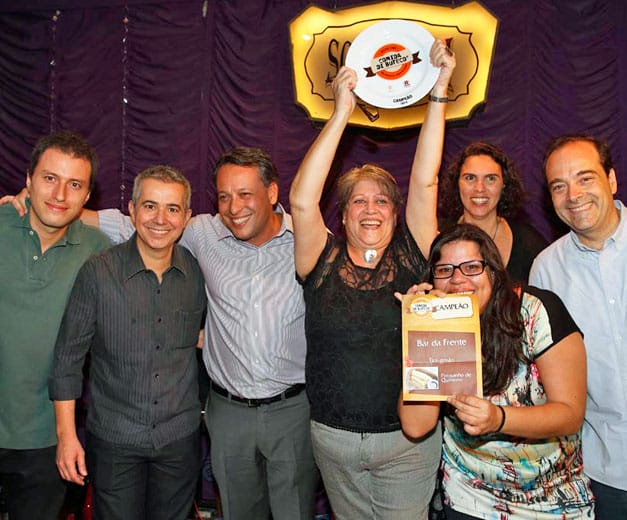Editor’s note: This piece and the accompanying photos, from photographer and guest contributor Mark Alor Powell, offer a firsthand look at Mexico City’s enormous central produce market.
The first time I tried to photograph La Central de Abasto in Mexico City, it was without permission, which was utterly impossible. As I walked through the market’s immense corridors, every time I tried to get a shot I would begin to hear cackles and whistles from the vendors. Their chatter had a signature sound like a backwards catcall and it traveled through the high market rafters from one stand to another, like birds squawking in the treetops through a vast forest. This alarm would consequently bring a plain-clothes security guard, who blocked my passage and asked me to show my permission papers to take pictures. When I could produce nothing, I was escorted sternly and quickly outside the market doors. I tried my luck at shooting in another section of the market but, yet again, a rising whistle would start and another security guy would appear and cut me off. I gave up.
A few months later, I got a call from the cultural representative of a local dignitary asking me If I would be interested in taking pictures in the market to celebrate its 25th anniversary. I was elated and thrilled to have the chance to go back.

The Abasto is the largest wholesale market in the world and its scale feels like that of a mid-sized city. The offices adjoining the market, which eventually issued my permission paperwork, looked like any other governmental bureaucracy: a boring manicured garden out front, everything under fluorescent light inside, metal wastepaper baskets beside each desk, workers in drab gray and blue business suits and everyone shuffling papers and looking busy. But adorning many of the walls, where one would normally expect to see the portrait of a mayor or president, were instead photographs of different kinds of fruits – oranges, limes and papaya, mostly – all beautifully framed in full-bleed profiles. Here, everyone pledged their allegiance to wholesale produce. Finally, with a firm congratulatory handshake, I was handed my special papers: two stapled sheets of paper with a handful of different rubber stamps in black and red ink, plus a handful of official signatures all baroquely signed in large, sweeping strokes. It felt like I was getting a passport.
Back inside, I had the sensation of having landed in the middle of a strange new world, which seemed almost like a mashup of Alice in Wonderland, Blade Runner and a Brothers Grimm fairy tale. Everywhere there was the throb of the passing crowd, as dense as in a subway transfer tunnel. An entire network of auxiliary houses offered everything from breakfast and lunch to hardware, neon signage, electronics, child-care centers, small church chapels, barbers, cell phone vendors and shoe shiners. A continuous low-hum noise came from a series of conveyor belts behind the vendors’ stands that kept bringing in more and more produce. An army of individual handcart operators called cargadores pushed their diablitos (“little devils”) loaded with goods in a vast distribution and delivery network through the veins of the market.

The market is set up thematically by type of produce. I headed past the tomato corridor, the oranges and watermelon hallways and the potato section to start taking photos. The produce here is stacked high in pyramids to impress passing eyes; each stand tries to outdo its neighbors, resulting in a visual arms race, with giant dramatic palettes of color marking the divisions all along the corridors.
Just as before, like clockwork the whistles rose up every time I brought my camera to my face, and a security guy approached and asked to see my paperwork; this happened more than a dozen times. I learned later that there is a genuine concern in the market about theft and heists – not so much of the produce itself but of the vast amount of cash exchanging hands on a daily basis. There is also a kidnapping problem. Small merchants are usually the primary targets for secuestros, so there is a general paranoia when cameras are around.
I met a potato salesman, who brought me into his back office to show me around. On his desk, a clump of potatoes was perched like a paperweight. Several plaques hanging on the wood-paneled walls commemorated his service as a food distributor over the years. Just as pets tend to look like their owners in the outside world, here in the market, produce looks like its seller. The potato salesman really looked like Mr. Potato Head. It was magical. Flashing a glinting smile, he told me he sold around two tons of potatoes each day.

Eventually, I found my way to the outdoor section of the market, comprised of several plots the size of football fields that are set together, remnants of farmland that an expanding Mexico City gobbled up long ago. This part of the market is used mainly for seasonal produce, plants and the thousands of flowers sold daily from wide tin sheds. It was the week before the Day of the Dead and the outside was splashed in orange from cut piles of Mexican cempasuchiles (marigolds), which were stacked high like small buildings. Quesadilla stands catered to weary-eyed truckers who had just dropped off recent loads. Meanwhile, clowns and musicians entertained the crowd. A black line of diesel exhaust from the distant roadway indicated that even more trucks were coming. It was seemingly endless.
From this viewpoint, I could feel the tension of the city, its hunger and constant need, like an ever-present mouth crying from all sides of the market. Yet, still, there was a feeling, a strong essence, of nostalgia for old-time farm values, as if this were a party after the harvest. Smoke from roasted yams drifted under my nose and orange continued to fill my eyes, as the blue sky above contrasted perfectly with the flowers and a strong eddy of dust suddenly blew against me.
This was definitely a place where people followed the crumbs home.
 June 6, 2019 A Powerful Greek Breakfast
June 6, 2019 A Powerful Greek Breakfast
Pictured is an invigorating Greek breakfast of yogurt, honey and walnuts at a local […] Posted in Athens March 9, 2015 Mama Roux
March 9, 2015 Mama Roux
In Athens, apart from traditional or nouvelle Greek, you can find almost any kind of […] Posted in Athens June 2, 2014 Best in Show
June 2, 2014 Best in Show
And the winner is... Okay, okay, it’s nothing like the Oscar ceremony. But everyone in […] Posted in Rio
Mark Alor PowellMark Alor Powell
Published on January 31, 2013
Related stories
June 6, 2019
Athens | By Culinary Backstreets
AthensPictured is an invigorating Greek breakfast of yogurt, honey and walnuts at a local institution. This is how we begin our culinary walk of downtown Athens!
March 9, 2015
AthensIn Athens, apart from traditional or nouvelle Greek, you can find almost any kind of cuisine you crave, but usually not under one roof. Thanks to the influx of immigrants and diaspora Greeks in the past 20 years, the city’s roster of foreign restaurants is no longer confined to Italian, French and a sprinkling of…
June 2, 2014
RioAnd the winner is... Okay, okay, it’s nothing like the Oscar ceremony. But everyone in attendance at Comida di Buteco 2014 – the most important popular gastronomy competition in Rio – did hold a collective breath moments before the winner was announced. When the hostess proclaimed Bar da Frente the victor, the Rio Scenarium, the…



















































































